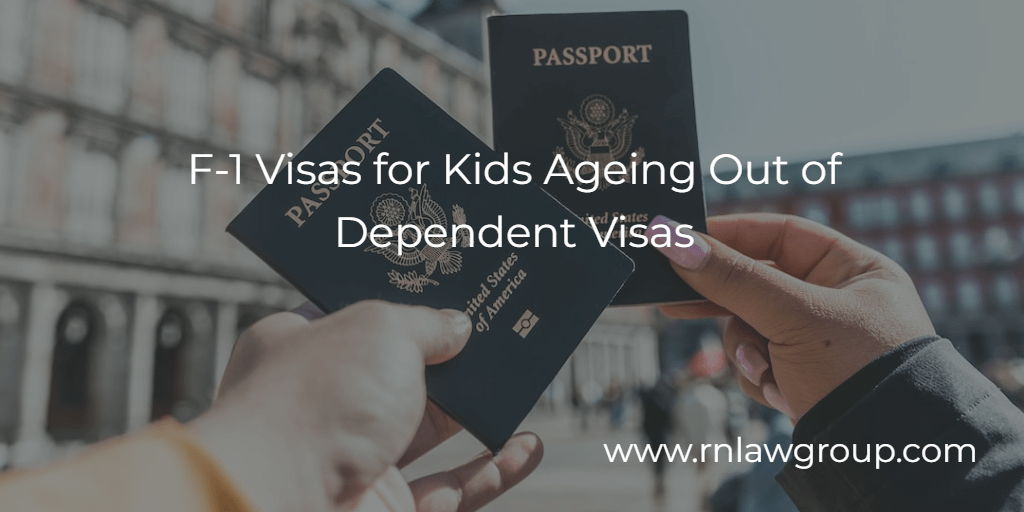
F-1 Visas for Kids Ageing Out of Dependent Visas
What Does Ageing Out Mean?
Foreign nationals who were brought to the United States as minors and do not have legal immigration status are frequently referred to as “Dreamers.” More recently, the focus on Dreamers has grown to include a distinct group that is also at risk of being expelled from the country, frequently after spending a large portion of their childhood here.
These people, sometimes known as legal Dreamers or documented Dreamers, are the offspring of nonimmigrant (i.e., temporary) workers who are either about to lose their legal status or may already have done so. The rise in the employment-based (EB) line, or backlog, is what gives rise to the legal Dreamer population.
H-4 and L-2 dependent children are not eligible to continue their status upon turning 21 years of age. This has not previously been an issue because the H-1B or L-1 parent often received his or her green card prior to the child turning 21, allowing the child to also receive the green card as a derivative of the parent’s principal application. However, as the green card backlog continues to grow for those born in India and China, more and more children are at risk of ageing out of their dependent status before their parents are able to receive their green cards.
How Many Legal Dreamers Are There?
There is no official information on the number of legally recognized Dreamers. As with Dreamers, there are no set standards for what constitutes a Legal Dreamer. According to one analysis, there are approximately 250,000 children in the EB line as a whole, and there are approximately 100,000 youngsters who might potentially lose their legal status over the next 20 years. This estimate excludes people who have already aged out and do not yet hold LPR status, as well as new applicants to the EB queue who may do so over the next two decades. Other projections with specific potential Legal Dreamer laws have surfaced. One estimate, for instance, put the number at 190,000 for H.R. 6, a bill that would have offer Legal Dreamers conditional permanent residence.
Doesn’t the Child Status Protection Act Help?
The Child Status Protection Act (CSPA) offers limited benefits for employment-based green card applicants who cannot file the I-485 application for adjustment of status because a visa number is not available based on their country of birth and category. CSPA simply takes into consideration the amount of time the underlying I-140 immigrant petition was pending for the parent and subtracts that time from the child’s age. If that would render the child under 21 when the parents become eligible to file the I-485 application, then the child can be included as well and CSPA locks the child’s age so that the derivative can receive the green card with the rest of the family even after turning 21. But, when the wait to be eligible to file the I-485 application is a decade or more and I-140 petitions typically take only a few months to process, more and more children will age out before their parents are eligible to file and will not be able to receive the green card with the family.
F-1 Student Status May be an Option
H-4 and L-2 children are eligible to attend elementary school, middle school, and high school in the United States. Upon graduation from high school, they can pursue education at the college or university level while still maintaining H-4 or L-2 status until they age out. They may then consider changing status to F-1 for international students by the time they turn 21.
A student seeking the F-1 nonimmigrant category must be a bona fide student qualified to pursue a full course of study, have a residence abroad they do not intend to abandon, and have been accepted to pursue a full course of study at a DHS-approved institution.
The Immigration and Nationality Act requires that an F-1 applicant possess a residence in a foreign country they have no intention of abandoning. Consequently, the student must prove that her or she:
- has a residence abroad;
- has no immediate intention of abandoning that residence; and
- intends to depart from the United States upon completion of approved activities.
How Can a Student Who Has Been Living in the U.S. in H-4 or L-2 Status Qualify for F-1?
In September of 2022, consular officers were directed to view student visa applications differently because students typically lack the strong economic and social ties of more established visa applicants and they plan longer stays in the United States. The law assumes that the natural circumstances of being a student do not disqualify the applicant from qualifying for a student visa. Consulates must consider the applicant’s present intent, not what they might do after a lengthy stay in the United States.
Furthermore, if a student visa applicant is residing with parents or guardians, a consular officer may still consider them to be maintaining a residence abroad if the officer is satisfied that the applicant has the present intent to depart the United States at the conclusion of their studies. The fact that this intention may change is not sufficient reason to deny a visa. In addition, the present intent to depart, does not imply the need to return to the country from which they hold a passport. It means only that they must intend to leave the United States upon completion of their studies. Given that most student visa applicants are young, they are not expected to have a long-range plan and may not be able to fully explain their plans at the conclusion of their studies. The officer must be satisfied at the time of the application for the visa that the applicant possessed the present intent to depart at the conclusion of their approved activities.
There are two ways to apply for the F-1 visa category: exit the United States and apply for an F-1 visa at a consulate or embassy abroad; or H-4 and L-2 dependents in the U.S. may file an I-539 application to change status with the U.S. Citizenship and Immigration Service (USCIS). The change of status process has been made easier in July 2021, when USCIS eliminated the requirement to file B-2 applications to continue nonimmigrant status after ageing out while the F-1 application remained pending.
The change of status process has been made easier in July 2021, when USCIS eliminated the requirement to file B-2 applications to continue nonimmigrant status after ageing out while the F-1 application remained pending
By: Emily Neumann
Emily Neumann is Managing Partner at Reddy Neumann Brown PC with over 15 years of experience practicing US immigration law providing services to U.S. businesses and multinational corporations. Emily has helped transform the firm from a solo practice to Houston’s largest immigration law firm focused exclusively on U.S. employment-based immigration. She received her Bachelor’s degree in Biology from Central Michigan University and her Juris Doctorate degree from the University of Houston Law Center. Emily has been quoted in Bloomberg Law, U.S. News & World Report, Inside Higher Ed, and The Times of India on various hot topics in immigration. She is a member of the American Immigration Lawyers Association and Society for Human Resource Management.
In today’s global economy, being able to navigate the immigration process is critical to your business success. If you are a Legal Dreamer ageing out and interested in the F-1 student visa, speak with one of our immigration lawyers. Please contact us online, call our Houston business immigration attorney office directly at 713-953-7787, or schedule a consultation.

